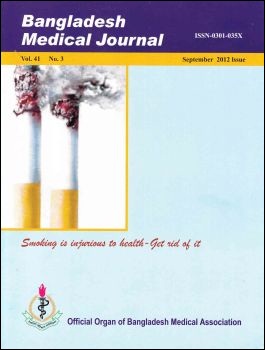Clinical Profile and Ultrasonographic Evaluation of Brain in Perinatal Asphyxia
DOI:
https://doi.org/10.3329/bmj.v41i3.18956Keywords:
perinatal asphlxia, ultrasonography of brain in perinatal asphyxiaAbstract
This descriptive cross sectional study was carried out in the department of paediatrics, Mymensingh Medical College Hospital from March 2006 to December 2006. This study was performed on 100 consecutive asphyxiated newborns who were admitted in Mymensingh Medical College Hospital during the study period. Among them, 50 babies were preterm and 50 babies were full term with moderate to severe perinatal asphyxia. Full term (>37 weeks of gestation) and preterm (<37 weeks of gestation) newborn babies with perinatal asphyxia was taken as case in inclusion criteria. Among the preterm babies, highest number 23(46%) were in the age group o/ 34-36 weeks of gestational age and among the term babies, highest number 24(48%) were in the age group of 39-40 weeks of gestational age. This study shows that 39% mothers had prolong obstructed labour, 21% had premature rupture membrane and 17% had pre-eclamptic toxaemia during pregnancy,. Convulsion 66%, poor primitive reflexes 52%, cyanosis 49% pallor 32%, respiratory distress 32% and apnoic spells 26% were the common presentations of asphyxiated babies. Out of 50 preterm asphyxiated newborn, one showed periventricular leukomalacia, two IVH and two ventricular dilatation. In the present study abnormal sonogram were detected in ten term babies. Two cases showed features of cerebral oedema and eight cases showed mild to moderate ventriculomegaly together with several subcortical cystic lesions of varying size. In case of comparison, eight cases had ventricular dilatation in term babies while 2 cases had in preterm babies. None of the term babies had ventricular haemorrhage but 2 had in preterm babies. Only, one preterm baby had periventricular leukomalacia but none among the term babies. There were 2 cases of cerebral oedema in term babies but none in preterm babies. Thus ultrasonography helps early recognition of intracranial abnormalities in asphyxiated newborns. So prognosis may be assessed, complication may be anticipated and appropriate management plan can be designed.
DOI: http://dx.doi.org/10.3329/bmj.v41i3.18956
Bangladesh Medical Journal 2012 Vol.41(3): 33-37
Downloads
167
190

